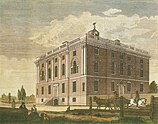From today's featured articleJames Abram Garfield (1831–1881) was the 20th president of the United States, serving from March 4 to September 19, 1881. Garfield was born into poverty in a log cabin in Northeast Ohio. He was a Union major general during the American Civil War. Elected to Congress in 1862 to represent Ohio's 19th district, he served nine terms, gaining a reputation as a skilled orator. He also wrote a notable proof of the Pythagorean theorem, published in 1876. Selected as a compromise candidate at the 1880 Republican National Convention, Garfield won the general election. As president he oversaw a resurgence of presidential authority against senatorial courtesy in executive appointments, a purge of corruption in the Post Office, and the appointment of a Supreme Court justice. Garfield advocated an educated electorate and civil rights for African Americans. He was shot on July 2, 1881, and died from infections caused by his doctors. ( This article is part of a featured topic: 1880 United States presidential election.)
Recently featured:
Did you know ...
|
In the news
On this dayFebruary 21: Language Movement Day in Bangladesh ( 1952); Family Day in Canada (2022); Washington's Birthday / Presidents' Day in the United States (2022)
More anniversaries:
|
From today's featured list
The seven symphonies of the Finnish composer Jean Sibelius, written between 1899 and 1924, are the core of his oeuvre and stalwarts of the standard concert repertoire. Many of classical music's conductor–orchestra partnerships have recorded the complete set, colloquially known as the "Sibelius cycle". Although early advocates such as Robert Kajanus, Sir Thomas Beecham, and Serge Koussevitzky had conducted many of Sibelius's symphonies for gramophone in the 1930s and 1940s, none of these Sibelians recorded all seven. The earliest complete traversal dates to 1953, four years before the composer's death on 20 September 1957; it is by Sixten Ehrling and the Stockholm Radio Orchestra, recorded from 1952–1953 for the Swedish label Metronome Records (released by Mercury Records in the United States). Ehrling had outpaced Anthony Collins and the London Symphony Orchestra, whose cycle—recorded from 1952–1955 on Decca Records—was concurrent with Ehrling's but arrived second. Since the pioneering examples of Ehrling and Collins, the Sibelius cycle has been recorded an additional 42 times as of July 2021. ( Full list...)
Today's featured picture

|
The Birth of the Milky Way, also known as The Origin of the Milky Way, is an oil-on-canvas painting by the Flemish artist Peter Paul Rubens, produced between 1636 and 1638 and featuring the Greco-Roman myth of the origin of the Milky Way. The painting depicts Hera ( Juno), spilling her breast milk, the infant Heracles ( Hercules) and Zeus ( Jupiter) in the background. Hera/Juno's face is modelled on Rubens's wife, Hélène Fourment. The carriage is pulled by peacocks, a bird which the ancient Greeks and Romans considered sacred to the goddess. The painting was a part of the commission from Philip IV of Spain to decorate Torre de la Parada. It is now held at the Museo del Prado in Madrid. Painting credit: Peter Paul Rubens
Recently featured:
|
Other areas of Wikipedia
- Community portal – Bulletin board, projects, resources and activities covering a wide range of Wikipedia areas.
- Help desk – Ask questions about using Wikipedia.
- Reference desk – Serving as virtual librarians, Wikipedia volunteers tackle your questions on a wide range of subjects.
- Site news – Announcements, updates, articles and press releases on Wikipedia and the Wikimedia Foundation.
- Teahouse – To ask your first basic questions about contributing to Wikipedia.
- Village pump – For discussions about Wikipedia itself, including areas for technical issues and policies.
Wikipedia's sister projects
Wikipedia is written by volunteer editors and hosted by the Wikimedia Foundation, a non-profit organization that also hosts a range of other volunteer projects:
-
Commons
Free media repository -
MediaWiki
Wiki software development -
Meta-Wiki
Wikimedia project coordination -
Wikibooks
Free textbooks and manuals -
Wikidata
Free knowledge base -
Wikinews
Free-content news -
Wikiquote
Collection of quotations -
Wikisource
Free-content library -
Wikispecies
Directory of species -
Wikiversity
Free learning tools -
Wikivoyage
Free travel guide -
Wiktionary
Dictionary and thesaurus
Wikipedia languages
This Wikipedia is written in English. Many other Wikipedias are available; some of the largest are listed below.
-
1,000,000+ articles
-
250,000+ articles
-
50,000+ articles
From today's featured articleJames Abram Garfield (1831–1881) was the 20th president of the United States, serving from March 4 to September 19, 1881. Garfield was born into poverty in a log cabin in Northeast Ohio. He was a Union major general during the American Civil War. Elected to Congress in 1862 to represent Ohio's 19th district, he served nine terms, gaining a reputation as a skilled orator. He also wrote a notable proof of the Pythagorean theorem, published in 1876. Selected as a compromise candidate at the 1880 Republican National Convention, Garfield won the general election. As president he oversaw a resurgence of presidential authority against senatorial courtesy in executive appointments, a purge of corruption in the Post Office, and the appointment of a Supreme Court justice. Garfield advocated an educated electorate and civil rights for African Americans. He was shot on July 2, 1881, and died from infections caused by his doctors. ( This article is part of a featured topic: 1880 United States presidential election.)
Recently featured:
Did you know ...
|
In the news
On this dayFebruary 21: Language Movement Day in Bangladesh ( 1952); Family Day in Canada (2022); Washington's Birthday / Presidents' Day in the United States (2022)
More anniversaries:
|
From today's featured list
The seven symphonies of the Finnish composer Jean Sibelius, written between 1899 and 1924, are the core of his oeuvre and stalwarts of the standard concert repertoire. Many of classical music's conductor–orchestra partnerships have recorded the complete set, colloquially known as the "Sibelius cycle". Although early advocates such as Robert Kajanus, Sir Thomas Beecham, and Serge Koussevitzky had conducted many of Sibelius's symphonies for gramophone in the 1930s and 1940s, none of these Sibelians recorded all seven. The earliest complete traversal dates to 1953, four years before the composer's death on 20 September 1957; it is by Sixten Ehrling and the Stockholm Radio Orchestra, recorded from 1952–1953 for the Swedish label Metronome Records (released by Mercury Records in the United States). Ehrling had outpaced Anthony Collins and the London Symphony Orchestra, whose cycle—recorded from 1952–1955 on Decca Records—was concurrent with Ehrling's but arrived second. Since the pioneering examples of Ehrling and Collins, the Sibelius cycle has been recorded an additional 42 times as of July 2021. ( Full list...)
Today's featured picture

|
The Birth of the Milky Way, also known as The Origin of the Milky Way, is an oil-on-canvas painting by the Flemish artist Peter Paul Rubens, produced between 1636 and 1638 and featuring the Greco-Roman myth of the origin of the Milky Way. The painting depicts Hera ( Juno), spilling her breast milk, the infant Heracles ( Hercules) and Zeus ( Jupiter) in the background. Hera/Juno's face is modelled on Rubens's wife, Hélène Fourment. The carriage is pulled by peacocks, a bird which the ancient Greeks and Romans considered sacred to the goddess. The painting was a part of the commission from Philip IV of Spain to decorate Torre de la Parada. It is now held at the Museo del Prado in Madrid. Painting credit: Peter Paul Rubens
Recently featured:
|
Other areas of Wikipedia
- Community portal – Bulletin board, projects, resources and activities covering a wide range of Wikipedia areas.
- Help desk – Ask questions about using Wikipedia.
- Reference desk – Serving as virtual librarians, Wikipedia volunteers tackle your questions on a wide range of subjects.
- Site news – Announcements, updates, articles and press releases on Wikipedia and the Wikimedia Foundation.
- Teahouse – To ask your first basic questions about contributing to Wikipedia.
- Village pump – For discussions about Wikipedia itself, including areas for technical issues and policies.
Wikipedia's sister projects
Wikipedia is written by volunteer editors and hosted by the Wikimedia Foundation, a non-profit organization that also hosts a range of other volunteer projects:
-
Commons
Free media repository -
MediaWiki
Wiki software development -
Meta-Wiki
Wikimedia project coordination -
Wikibooks
Free textbooks and manuals -
Wikidata
Free knowledge base -
Wikinews
Free-content news -
Wikiquote
Collection of quotations -
Wikisource
Free-content library -
Wikispecies
Directory of species -
Wikiversity
Free learning tools -
Wikivoyage
Free travel guide -
Wiktionary
Dictionary and thesaurus
Wikipedia languages
This Wikipedia is written in English. Many other Wikipedias are available; some of the largest are listed below.
-
1,000,000+ articles
-
250,000+ articles
-
50,000+ articles




